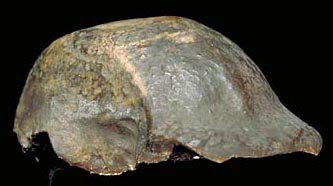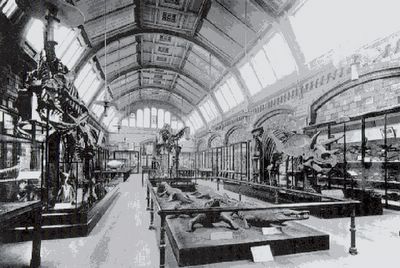Monday, January 30, 2012
Published This Day: Darwin's Other Book
From Today In Science History:
In 1868, Charles Darwin's book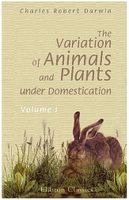 - Variation of Animals and Plants under Domestication - was published. He was 58. It is probably the second in importance of all his works. This was a follow-up work, written in response to criticisms that his theory of evolution was unsubstantiated. Darwin here supports his views via analysis of various aspects of plant and animal life, including an inventory of varieties and their physical and behavioral characteristics, and an investigation of the impact of a species' surrounding environment and the effect of both natural and forced changes in this environment.
- Variation of Animals and Plants under Domestication - was published. He was 58. It is probably the second in importance of all his works. This was a follow-up work, written in response to criticisms that his theory of evolution was unsubstantiated. Darwin here supports his views via analysis of various aspects of plant and animal life, including an inventory of varieties and their physical and behavioral characteristics, and an investigation of the impact of a species' surrounding environment and the effect of both natural and forced changes in this environment.
In 1868, Charles Darwin's book
 - Variation of Animals and Plants under Domestication - was published. He was 58. It is probably the second in importance of all his works. This was a follow-up work, written in response to criticisms that his theory of evolution was unsubstantiated. Darwin here supports his views via analysis of various aspects of plant and animal life, including an inventory of varieties and their physical and behavioral characteristics, and an investigation of the impact of a species' surrounding environment and the effect of both natural and forced changes in this environment.
- Variation of Animals and Plants under Domestication - was published. He was 58. It is probably the second in importance of all his works. This was a follow-up work, written in response to criticisms that his theory of evolution was unsubstantiated. Darwin here supports his views via analysis of various aspects of plant and animal life, including an inventory of varieties and their physical and behavioral characteristics, and an investigation of the impact of a species' surrounding environment and the effect of both natural and forced changes in this environment.
Saturday, January 28, 2012
Born This Day: Eugene Dubois
Eugene Dubois (Jan. 28, 1858-Dec. 16, 1940) joined the Dutch Army as a medical officer, and used spare time from his medical duties to search for fossils, first in Sumatra and then in Java.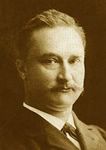 He searched on the banks of the Solo River, with two assigned engineers and a crew of convict labourers to help him. In September 1890, his workers found a human, or human-like, fossil at Koedoeng Broeboes. This consisted of the right side of the chin of a lower jaw and three attached teeth. In August 1891 he found a primate molar tooth.
He searched on the banks of the Solo River, with two assigned engineers and a crew of convict labourers to help him. In September 1890, his workers found a human, or human-like, fossil at Koedoeng Broeboes. This consisted of the right side of the chin of a lower jaw and three attached teeth. In August 1891 he found a primate molar tooth.
Two months later and one meter away was found an intact skullcap, the fossil which would be known as Java Man. In August 1892, a third primate fossil, an almost complete left thigh bone, was found between 10 and 15 meters away from the skullcap.
meter away was found an intact skullcap, the fossil which would be known as Java Man. In August 1892, a third primate fossil, an almost complete left thigh bone, was found between 10 and 15 meters away from the skullcap.
In 1894 Dubois published a description of his fossils, naming them Pithecanthropus erectus (now Home erectus), describing it as neither ape nor human, but something intermediate. In 1895 he returned to Europe to promote the fossil and his interpretation. A few scientists enthusiastically endorsed Dubois' work, but most disagreed with his interpretation. Many scientists pointed out similarities between the Java Man skullcap and Neandertal fossils.
Around 1900 Dubois ceased to discuss Java Man, and hid the fossils in his home while he moved on to other research topics. geology and paleontology. It was not until 1923 that Dubois, under pressure from scientists, once again allowed access to the Java Man fossils. That and the discovery of similar fossils caused it to once again become a topic of debate.
 He searched on the banks of the Solo River, with two assigned engineers and a crew of convict labourers to help him. In September 1890, his workers found a human, or human-like, fossil at Koedoeng Broeboes. This consisted of the right side of the chin of a lower jaw and three attached teeth. In August 1891 he found a primate molar tooth.
He searched on the banks of the Solo River, with two assigned engineers and a crew of convict labourers to help him. In September 1890, his workers found a human, or human-like, fossil at Koedoeng Broeboes. This consisted of the right side of the chin of a lower jaw and three attached teeth. In August 1891 he found a primate molar tooth.Two months later and one
 meter away was found an intact skullcap, the fossil which would be known as Java Man. In August 1892, a third primate fossil, an almost complete left thigh bone, was found between 10 and 15 meters away from the skullcap.
meter away was found an intact skullcap, the fossil which would be known as Java Man. In August 1892, a third primate fossil, an almost complete left thigh bone, was found between 10 and 15 meters away from the skullcap.In 1894 Dubois published a description of his fossils, naming them Pithecanthropus erectus (now Home erectus), describing it as neither ape nor human, but something intermediate. In 1895 he returned to Europe to promote the fossil and his interpretation. A few scientists enthusiastically endorsed Dubois' work, but most disagreed with his interpretation. Many scientists pointed out similarities between the Java Man skullcap and Neandertal fossils.
Around 1900 Dubois ceased to discuss Java Man, and hid the fossils in his home while he moved on to other research topics. geology and paleontology. It was not until 1923 that Dubois, under pressure from scientists, once again allowed access to the Java Man fossils. That and the discovery of similar fossils caused it to once again become a topic of debate.
Friday, January 27, 2012
Died This Day: Adam Sedgwick
From Today In Science History:
Sedgwick (March 22, 1785 - January 27, 1873) was an English geologist who first applied the name Cambrian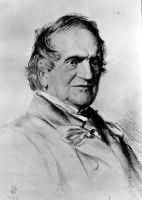 to the geologic period of time, now dated at 570 to 505 million years ago. In 1818 he became Woodwardian Professor of Geology at Cambridge, holding a chair that had been endowed ninety years before by the natural historian John Woodward.
to the geologic period of time, now dated at 570 to 505 million years ago. In 1818 he became Woodwardian Professor of Geology at Cambridge, holding a chair that had been endowed ninety years before by the natural historian John Woodward.
He lacked formal training in geology, but he quickly became an active researcher in geology and paleontology. Many years after Sedgwick's death, the geological museum at Cambridge was renamed the Sedgwick Museum of Geology in his honor. The museum is now part of the Department of Earth Sciences at Cambridge University
Sedgwick (March 22, 1785 - January 27, 1873) was an English geologist who first applied the name Cambrian
 to the geologic period of time, now dated at 570 to 505 million years ago. In 1818 he became Woodwardian Professor of Geology at Cambridge, holding a chair that had been endowed ninety years before by the natural historian John Woodward.
to the geologic period of time, now dated at 570 to 505 million years ago. In 1818 he became Woodwardian Professor of Geology at Cambridge, holding a chair that had been endowed ninety years before by the natural historian John Woodward.He lacked formal training in geology, but he quickly became an active researcher in geology and paleontology. Many years after Sedgwick's death, the geological museum at Cambridge was renamed the Sedgwick Museum of Geology in his honor. The museum is now part of the Department of Earth Sciences at Cambridge University
New Theory Explains Life, Universe, Everything! Really!
Theory of the Origin, Evolution, and Nature of Life. 2012.E. D. Andrulis. Life 2012: 1-105.
In addition to resolving long-standing paradoxes and puzzles in chemistry and biology, Dr. Andrulis’ theory unifies quantum and celestial mechanics. His unorthodox solution to this quintessential problem in physics differs from mainstream approaches, like string theory, as it is simple, non-mathematical, and experimentally and experientially verifiable. As such, the new portrait of quantum gravity is radical.
The basic idea of Dr. Andrulis’ framework is that all physical reality can be modeled by a single geometric entity with life-like characteristics: the gyre. The so-called “gyromodel” depicts objects—particles, atoms, chemicals, molecules, and cells—as quantized packets of energy and matter that cycle between excited and ground states around a singularity, the gyromodel’s center. A singularity is itself modeled as a gyre, wholly compatible with the thermodynamic and fractal nature of life.
By fitting the gyromodel to facts accumulated over scientific history, Dr. Andrulis confirms the proposed existence of eight laws of nature. One of these, the natural law of unity, decrees that the living cell and any part of the visible universe are irreducible. This law formally establishes that there is one physical reality.
Another natural law dictates that the atomic and cosmic realms abide by identical organizational constraints. Simply put, atoms in the human body and solar systems in the universe move and behave in the exact same manner.
Dr. Andrulis has used his theory to successfully predict and identify a hidden signature of RNA biogenesis in his laboratory at Case Western Reserve University School of Medicine. He is now applying the gyromodel to unify and explain the evolution and development of human beings. Link
The Earth is alive, asserts a revolutionary scientific theory of life emerging from Case Western Reserve University School of Medicine. The trans-disciplinary theory demonstrates that purportedly inanimate, non-living objects—for example, planets, water, proteins, and DNA—are animate, that is, alive.The theory explains not only the evolutionary emergence of life on earth and in the universe but also the structure and function of existing cells and biospheres.
In addition to resolving long-standing paradoxes and puzzles in chemistry and biology, Dr. Andrulis’ theory unifies quantum and celestial mechanics. His unorthodox solution to this quintessential problem in physics differs from mainstream approaches, like string theory, as it is simple, non-mathematical, and experimentally and experientially verifiable. As such, the new portrait of quantum gravity is radical.
The basic idea of Dr. Andrulis’ framework is that all physical reality can be modeled by a single geometric entity with life-like characteristics: the gyre. The so-called “gyromodel” depicts objects—particles, atoms, chemicals, molecules, and cells—as quantized packets of energy and matter that cycle between excited and ground states around a singularity, the gyromodel’s center. A singularity is itself modeled as a gyre, wholly compatible with the thermodynamic and fractal nature of life.
By fitting the gyromodel to facts accumulated over scientific history, Dr. Andrulis confirms the proposed existence of eight laws of nature. One of these, the natural law of unity, decrees that the living cell and any part of the visible universe are irreducible. This law formally establishes that there is one physical reality.
Another natural law dictates that the atomic and cosmic realms abide by identical organizational constraints. Simply put, atoms in the human body and solar systems in the universe move and behave in the exact same manner.
Dr. Andrulis has used his theory to successfully predict and identify a hidden signature of RNA biogenesis in his laboratory at Case Western Reserve University School of Medicine. He is now applying the gyromodel to unify and explain the evolution and development of human beings. Link
Thursday, January 26, 2012
American Mastodon Stop-Motion Trailer
Brad Ricca, a SAGES Fellow at Case Western Reserve University in Cleveland who teaches classes on comic books and biography, is earning accolades for a more traditional form of literature: poetry.
Among those accolades is the honor of having Garrison Keillor personally select his poem “The Beautiful Sandwich” to read Thursday, Jan. 26, on his national NPR show The Writer’s Almanac.
His first book of verse, American Mastodon, won the St. Lawrence Book Award. The prize is awarded yearly to an unpublished collection of poems or short stories, which is then published by Black Lawrence Press
.
Ricca is well acquainted with superheroes both past and present, but it was another larger-than-life figure that inspired his book’s title. American Mastodon refers to a grand, shaggy mastodon with 15-foot curving tusks at the Cleveland Museum of Natural History. The prehistoric creature loomed large for Ricca, who visited the museum both as a child and as an adult.
His reaction, he said, was: “Here’s this massive animal that once freely roamed Earth and now doesn’t move an inch in the museum.” Link to The Daily
Trailer Credits: Animagination by Stu Howe (UK); Poem by Brad Ricca (USA)
Among those accolades is the honor of having Garrison Keillor personally select his poem “The Beautiful Sandwich” to read Thursday, Jan. 26, on his national NPR show The Writer’s Almanac.
His first book of verse, American Mastodon, won the St. Lawrence Book Award. The prize is awarded yearly to an unpublished collection of poems or short stories, which is then published by Black Lawrence Press
.
Ricca is well acquainted with superheroes both past and present, but it was another larger-than-life figure that inspired his book’s title. American Mastodon refers to a grand, shaggy mastodon with 15-foot curving tusks at the Cleveland Museum of Natural History. The prehistoric creature loomed large for Ricca, who visited the museum both as a child and as an adult.
His reaction, he said, was: “Here’s this massive animal that once freely roamed Earth and now doesn’t move an inch in the museum.” Link to The Daily
Dig this great retro-60's stop-motion trailer for the book:
Trailer Credits: Animagination by Stu Howe (UK); Poem by Brad Ricca (USA)
Born This Day: Roy Chapman Andrews
From the American Museum of Natural History web site:
Adventurer, administrator, and Museum promoter — Andrews (Jan. 26, 1884 – March 11, 1960) spent his entire career at the American Museum of Natural History, where he rose through the ranks from departmental assistant, to expedition organizer, to Museum director.
He became world famous as leader of the Central Asiatic Expeditions, a series of expeditions to Mongolia that collected, among other things, dinosaur eggs. Although on these expeditions, Andrews himself found few fossils, and during his career he was not known as an influential scientist, he instead filled the role of promoter, creating immense excitement and successfully advancing the research and exhibition goals of the museum.
Learn about the Roy Chapman Andrews Society HERE.
Wednesday, January 25, 2012
Palaeo Noir: Archaeopteryx
New evidence on the colour and nature of the isolated Archaeopteryx feather. 2012. R.M. Carney, et al. Nature Communications 3.
Abstract: Archaeopteryx has been regarded as an icon of evolution ever since its discovery from the Late Jurassic limestone deposits of Solnhofen, Germany in 1861. Here we report the first evidence of colour from Archaeopteryx based on fossilized colour-imparting melanosomes discovered in this isolated feather specimen.
Using a phylogenetically diverse database of extant bird feathers, statistical analysis of melanosome morphology predicts that the original colour of this Archaeopteryx feather was black, with 95% probability. Furthermore, reexamination of the feather's morphology leads us to interpret it as an upper major primary covert, contrary to previous interpretations.
Additional findings reveal that the specimen is preserved as an organosulphur residue, and that barbule microstructure identical to that of modern bird feathers had evolved as early as the Jurassic. As in extant birds, the extensive melanization would have provided structural advantages to the Archaeopteryx wing feather during this early evolutionary stage of dinosaur flight.
Abstract: Archaeopteryx has been regarded as an icon of evolution ever since its discovery from the Late Jurassic limestone deposits of Solnhofen, Germany in 1861. Here we report the first evidence of colour from Archaeopteryx based on fossilized colour-imparting melanosomes discovered in this isolated feather specimen.
Using a phylogenetically diverse database of extant bird feathers, statistical analysis of melanosome morphology predicts that the original colour of this Archaeopteryx feather was black, with 95% probability. Furthermore, reexamination of the feather's morphology leads us to interpret it as an upper major primary covert, contrary to previous interpretations.
Additional findings reveal that the specimen is preserved as an organosulphur residue, and that barbule microstructure identical to that of modern bird feathers had evolved as early as the Jurassic. As in extant birds, the extensive melanization would have provided structural advantages to the Archaeopteryx wing feather during this early evolutionary stage of dinosaur flight.
Massospondylus Nests
Oldest known dinosaurian nesting site and reproductive biology of the Early Jurassic sauropodomorph Massospondylus. 2012. R. Reisz et al. PNAS.
In 1976 an incomplete egg clutch including in ovo embryos of this dinosaur, the oldest known example in the fossil record, was collected from a road-cut talus. Recent work started in 2006 has yielded multiple in situ egg clutches, documenting the oldest known dinosaurian nesting site, predating other similar sites by more than 100 million years.
The presence of numerous clutches of eggs, some of which contain embryonic remains, in at least four distinct horizons within a small area, provides the earliest known evidence of complex reproductive behavior including site fidelity and colonial nesting in a terrestrial vertebrate.
A temporally calibrated optimization of dinosaurian reproductive biology not only demonstrates the primary significance of the Massospondylus nesting site, but also provides additional insights into the initial stages of the evolutionary history of dinosaurs, including evidence that deposition of eggs in a tightly organized single layer in a nest evolved independently from brooding.
Thanks to the PR folks for providing the smallest possible version of a great illo by Julius CsotonyiAbstract [edit]: The extensive Early Jurassic continental strata of southern Africa have yielded an exceptional record of dinosaurs that includes scores of partial to complete skeletons of the sauropodomorph Massospondylus, ranging from embryos to large adults.
In 1976 an incomplete egg clutch including in ovo embryos of this dinosaur, the oldest known example in the fossil record, was collected from a road-cut talus. Recent work started in 2006 has yielded multiple in situ egg clutches, documenting the oldest known dinosaurian nesting site, predating other similar sites by more than 100 million years.
The presence of numerous clutches of eggs, some of which contain embryonic remains, in at least four distinct horizons within a small area, provides the earliest known evidence of complex reproductive behavior including site fidelity and colonial nesting in a terrestrial vertebrate.
A temporally calibrated optimization of dinosaurian reproductive biology not only demonstrates the primary significance of the Massospondylus nesting site, but also provides additional insights into the initial stages of the evolutionary history of dinosaurs, including evidence that deposition of eggs in a tightly organized single layer in a nest evolved independently from brooding.
Sunday, January 22, 2012
End-Cretaceous Marine Mass Extinction Not Caused by Productivity Collapse
End-Cretaceous marine mass extinction not caused by productivity collapse. 2012. L. Alegret, et al. PNAS
Abstract: An asteroid impact at the end of the Cretaceous caused mass extinction, but extinction mechanisms are not well-understood. The collapse of sea surface to sea floor carbon isotope gradients has been interpreted as reflecting a global collapse of primary productivity (Strangelove Ocean) or export productivity (Living Ocean), which caused mass extinction higher in the marine food chain. Phytoplankton-dependent benthic foraminifera on the deep-sea floor, however, did not suffer significant extinction, suggesting that export productivity persisted at a level sufficient to support their populations.
We compare benthic foraminiferal records with benthic and bulk stable carbon isotope records from the Pacific, Southeast Atlantic, and Southern Oceans. We conclude that end-Cretaceous decrease in export productivity was moderate, regional, and insufficient to explain marine mass extinction.
A transient episode of surface ocean acidification may have been the main cause of extinction of calcifying plankton and ammonites, and recovery of productivity may have been as fast in the oceans as on land. image link
Abstract: An asteroid impact at the end of the Cretaceous caused mass extinction, but extinction mechanisms are not well-understood. The collapse of sea surface to sea floor carbon isotope gradients has been interpreted as reflecting a global collapse of primary productivity (Strangelove Ocean) or export productivity (Living Ocean), which caused mass extinction higher in the marine food chain. Phytoplankton-dependent benthic foraminifera on the deep-sea floor, however, did not suffer significant extinction, suggesting that export productivity persisted at a level sufficient to support their populations.
We compare benthic foraminiferal records with benthic and bulk stable carbon isotope records from the Pacific, Southeast Atlantic, and Southern Oceans. We conclude that end-Cretaceous decrease in export productivity was moderate, regional, and insufficient to explain marine mass extinction.
A transient episode of surface ocean acidification may have been the main cause of extinction of calcifying plankton and ammonites, and recovery of productivity may have been as fast in the oceans as on land. image link
Thursday, January 19, 2012
The Caudal Basket of Pachycephalosauria
Homology and Architecture of the Caudal Basket of Pachycephalosauria (Dinosauria: Ornithischia): The First Occurrence of Myorhabdoi in Tetrapoda. 2012. C.M. Brown and A.P. Russell. PLoS ONE 7(1): e30212.
Abstract [edit]: Associated postcranial skeletons of pachycephalosaurids, most notably those of Stegoceras and Homalocephale, reveal enigmatic osseous structures not present in other tetrapod clades. The homology and functional significance of these structures have remained elusive as they were originally interpreted to be abdominal ribs or gastralia, and more recently have been interpreted as de novo structures in the tail.
Analysis of these structures in nearly all pachycephalosaurid skeletons has facilitated a complete description of their architecture, and the establishment of patterns consistent with those of myorhabdoid ossifications — ossifications of the myoseptal tendons associated with myomeres. The presence and structure of myorhabdoid ossifications are well established for teleost fish, but this marks their first recognition within Tetrapoda. These elements are both structurally and histologically distinct from the deep, paraxial ossified tendon bundles of other ornithischian clades, although they may have performed a similar function in the stiffening of the tail.
These myorhabdoi are not de novo structures, but are instead ossifications (and therefore more amenable to fossilization) of the normally unossified plesiomorphic caudal myosepta of vertebrates. The ubiquitous ossification of these structures in pachycephalosaurids (all specimens preserving the tail also exhibit myorhabdoid ossifications) suggests it is a likely synapomorphic condition for Pachycephalosauria.
Abstract [edit]: Associated postcranial skeletons of pachycephalosaurids, most notably those of Stegoceras and Homalocephale, reveal enigmatic osseous structures not present in other tetrapod clades. The homology and functional significance of these structures have remained elusive as they were originally interpreted to be abdominal ribs or gastralia, and more recently have been interpreted as de novo structures in the tail.
Analysis of these structures in nearly all pachycephalosaurid skeletons has facilitated a complete description of their architecture, and the establishment of patterns consistent with those of myorhabdoid ossifications — ossifications of the myoseptal tendons associated with myomeres. The presence and structure of myorhabdoid ossifications are well established for teleost fish, but this marks their first recognition within Tetrapoda. These elements are both structurally and histologically distinct from the deep, paraxial ossified tendon bundles of other ornithischian clades, although they may have performed a similar function in the stiffening of the tail.
These myorhabdoi are not de novo structures, but are instead ossifications (and therefore more amenable to fossilization) of the normally unossified plesiomorphic caudal myosepta of vertebrates. The ubiquitous ossification of these structures in pachycephalosaurids (all specimens preserving the tail also exhibit myorhabdoid ossifications) suggests it is a likely synapomorphic condition for Pachycephalosauria.
Paleobiology Database Intensive Workshop in Analytical Methods
The Paleobiology Database has sponsored a five-week intensive training workshop in analytical methods since 2005. The Australian Research Council and the National Science Foundation's Division of Earth Sciences will provide funding for the 2012 edition. As in 2010 and 2011, the 2012 workshop will held at Macquarie University in Sydney. Sessions will be held between 25 June and 29 July.
Topics will include community paleoecology, diversity curves, speciation and extinction, phylogenetics, phenotypic evolution, and morphometrics. Both simulation modelling and data analysis methods will be employed. Training will combine lectures and labs. Participants will be given hands-on instruction in programming using R and taught to use other analytical software. In addition to the workshop coordinator, each week a new instructor will be present. The instructors are expected to be John Alroy, Gene Hunt, Tom Olszewski, David Polly, and Pete Wagner.
There is no fee for registration and participants will be housed for free in accommodations near the campus. Daily expenses such as meal costs are not subsidized but are only on the order of $10 to $15. Participants are encouraged to solicit travel funds from their home institutions or other organizations. A majority of airfare costs will be reimbursed if such funds are not available. There are no other charges of any kind and no other major expenses are likely.
For all the details go here: Paleobiology Database Intensive Workshop in Analytical Methods.
NOTE: Applications received by the end of Monday, 15 February 2012 get priority. Only a few spaces are available so apply early and often.
Topics will include community paleoecology, diversity curves, speciation and extinction, phylogenetics, phenotypic evolution, and morphometrics. Both simulation modelling and data analysis methods will be employed. Training will combine lectures and labs. Participants will be given hands-on instruction in programming using R and taught to use other analytical software. In addition to the workshop coordinator, each week a new instructor will be present. The instructors are expected to be John Alroy, Gene Hunt, Tom Olszewski, David Polly, and Pete Wagner.
There is no fee for registration and participants will be housed for free in accommodations near the campus. Daily expenses such as meal costs are not subsidized but are only on the order of $10 to $15. Participants are encouraged to solicit travel funds from their home institutions or other organizations. A majority of airfare costs will be reimbursed if such funds are not available. There are no other charges of any kind and no other major expenses are likely.
For all the details go here: Paleobiology Database Intensive Workshop in Analytical Methods.
NOTE: Applications received by the end of Monday, 15 February 2012 get priority. Only a few spaces are available so apply early and often.
Died This Day: Frank Reicher
Frank Reicher (Dec. 2, 1875 - Jan. 19, 1965) was a German actor, director and  producer born in Munich, Germany. During the early part of the twentieth century he was often on Broadway, occasionally in leading roles, but he is most familiar to modern audiences as a supporting character actor in films.
producer born in Munich, Germany. During the early part of the twentieth century he was often on Broadway, occasionally in leading roles, but he is most familiar to modern audiences as a supporting character actor in films.
He is probably best known for playing Captain Englehorn in the movies King Kong and Son of Kong in 1933. link
 producer born in Munich, Germany. During the early part of the twentieth century he was often on Broadway, occasionally in leading roles, but he is most familiar to modern audiences as a supporting character actor in films.
producer born in Munich, Germany. During the early part of the twentieth century he was often on Broadway, occasionally in leading roles, but he is most familiar to modern audiences as a supporting character actor in films. He is probably best known for playing Captain Englehorn in the movies King Kong and Son of Kong in 1933. link
Siphusauctum gregarium from The Burgess Shale
A New Stalked Filter-Feeder from the Middle Cambrian Burgess Shale, British Columbia, Canada. 2012. L. J. O'Brien and J.-B. Caron. PLoS ONE 7(1): e29233
"Most interesting is that this feeding system appears to be unique among animals. Recent advances have linked many bizarre Burgess Shale animals as primitive members of many animal groups that are found today but Siphusauctum defies this trend. We do not know where it fits in relation to other organisms," said Lorna O'Brien. link
A bizarre creature that lived in the ocean more than 500 million years ago has emerged from the famous Middle Cambrian Burgess Shale in the Canadian Rockies.Siphusauctum gregarium (~20 cm long) has a long stem, with a calyx – a bulbous cup-like structure – near the top which encloses an unusual filter feeding system and a gut. The animal is thought to have fed by filtering particles from water actively pumped into its calyx through small holes. The stem ends with a small disc which anchored the animal to the seafloor. Siphusauctum lived in large clusters, as indicated by slabs containing over 65 individual specimens.
"Most interesting is that this feeding system appears to be unique among animals. Recent advances have linked many bizarre Burgess Shale animals as primitive members of many animal groups that are found today but Siphusauctum defies this trend. We do not know where it fits in relation to other organisms," said Lorna O'Brien. link
Monday, January 16, 2012
Born This Day: Caroline Munro
Munro is probably best known for her role in in the Bond film The Spy Who Loved Me (1977). She had a long career in a variety of genre films including a stint with Hammer Films, and notably with Ray Harryhausen as the slave girl, Margiana, in The Golden Voyage of Sinbad (1974).
She takes a bow on the Palaeoblog both for being the Godmother of Harryhausen’s daughter and for her role as Princess Dia in At the Earth’s Core (1976)
She takes a bow on the Palaeoblog both for being the Godmother of Harryhausen’s daughter and for her role as Princess Dia in At the Earth’s Core (1976)
Sunday, January 15, 2012
Opened To The Public (1759): The British Museum
On this day in 1759, the British Museum, in Bloomsbury, London, the world's oldest public national museum, opened to the public who were admitted in small groups, by ticket obtained in advance, for a conducted tour.
It was established on June 7, 1753 when King George II gave his royal assent to an Act of Parliament to acquire the collection of Sir Hans Sloane. In his will, he had offered the nation his lifetime collection of 71,000 objects, mostly plant and animal specimens. In return, he requested £20,000 for his heirs (which today would be over £2,000,000). The present museum buildings date from the mid-19th century. Its natural history collection moved to its own museum in 1881. link
It was established on June 7, 1753 when King George II gave his royal assent to an Act of Parliament to acquire the collection of Sir Hans Sloane. In his will, he had offered the nation his lifetime collection of 71,000 objects, mostly plant and animal specimens. In return, he requested £20,000 for his heirs (which today would be over £2,000,000). The present museum buildings date from the mid-19th century. Its natural history collection moved to its own museum in 1881. link
Died This Day: Jean-Baptiste-Julien d' Omalius d' Halloy
 d'Halloy (Feb. 16, 1783 - Jan. 15, 1875) was a Belgian geologist who was an early proponent of evolution and was acknowledged by Charles Darwin in his preface to ‘On The Origin of the Species’ for his opinions on the origin of new species through descent with modification.
d'Halloy (Feb. 16, 1783 - Jan. 15, 1875) was a Belgian geologist who was an early proponent of evolution and was acknowledged by Charles Darwin in his preface to ‘On The Origin of the Species’ for his opinions on the origin of new species through descent with modification.He determined the stratigraphy of the Carboniferous and other rocks in Belgium and the Rhine provinces, and also made detailed studies of the Tertiary deposits of the Paris Basin. link
Tuesday, January 10, 2012
Died This Day: Carolus Linnaeus
Born May 23, 1707 – Jan. 10, 1778.
From the Linnean Society:
Linnaeus was born in 1707 in Sweden. He headed an expedition to Lapland in 1732, travelling 4,600 miles and crossing the Scandinavian Peninsula by foot to the Arctic Ocean. On the journey he discovered a hundred botanical species. He undertook his medical degree in 1735 in the Netherlands. In 1735, he published Systema Naturae, his classification of plants based on their sexual parts.
species. He undertook his medical degree in 1735 in the Netherlands. In 1735, he published Systema Naturae, his classification of plants based on their sexual parts.
His method of binomial nomenclature using genus and species names was further expounded when he published Fundamenta Botanica (1736) and Classes Plantarum (1738). This system used the flower and the number and arrangements of its sexual organs of stamens and pistils to group plants into twenty-four classes which in turn are divided into orders, genera and species.
In his publications, Linnaeus provided a concise, usable survey of all the world's plants and animals as then known, about 7,700 species of plants and 4,400 species of animals. These works helped to establish and standardize the consistent binomial nomenclature for species which he introduced on a world scale for plants in 1753, and for animals in 1758, and which is used today.
His Systema Naturae 10th edition, volume 1(1758), has accordingly been accepted by international agreement as the official starting point for zoological nomenclature. Scientific names published before then have no validity unless adopted by Linnaeus or by later authors. This confers a high scientific importance on the specimens used by Linnaeus for their preparation, many of which are in his personal collections now treasured by the Linnean Society.
He was granted nobility in 1761, becoming Carl von Linné. He continued his work of classification and as a physician, and remained Rector of the University until 1772.
From the Linnean Society:
Linnaeus was born in 1707 in Sweden. He headed an expedition to Lapland in 1732, travelling 4,600 miles and crossing the Scandinavian Peninsula by foot to the Arctic Ocean. On the journey he discovered a hundred botanical
 species. He undertook his medical degree in 1735 in the Netherlands. In 1735, he published Systema Naturae, his classification of plants based on their sexual parts.
species. He undertook his medical degree in 1735 in the Netherlands. In 1735, he published Systema Naturae, his classification of plants based on their sexual parts.His method of binomial nomenclature using genus and species names was further expounded when he published Fundamenta Botanica (1736) and Classes Plantarum (1738). This system used the flower and the number and arrangements of its sexual organs of stamens and pistils to group plants into twenty-four classes which in turn are divided into orders, genera and species.
In his publications, Linnaeus provided a concise, usable survey of all the world's plants and animals as then known, about 7,700 species of plants and 4,400 species of animals. These works helped to establish and standardize the consistent binomial nomenclature for species which he introduced on a world scale for plants in 1753, and for animals in 1758, and which is used today.
His Systema Naturae 10th edition, volume 1(1758), has accordingly been accepted by international agreement as the official starting point for zoological nomenclature. Scientific names published before then have no validity unless adopted by Linnaeus or by later authors. This confers a high scientific importance on the specimens used by Linnaeus for their preparation, many of which are in his personal collections now treasured by the Linnean Society.
He was granted nobility in 1761, becoming Carl von Linné. He continued his work of classification and as a physician, and remained Rector of the University until 1772.
Born This Day: Nicolaus Steno
Steno (Jan. 10 – Nov. 26, 1686) was a Danish geologist and anatomist who first made unprecedented discoveries in anatomy, then established 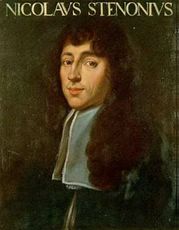 some of the most important principles of modern geology. He was Danish royal anatomist for 2 years.
some of the most important principles of modern geology. He was Danish royal anatomist for 2 years.
Interested by the characteristics and origins of minerals, rocks, and fossils, he published in Prodromus (1669) the law of superposition (if a series of sedimentary rocks has not been overturned, upper layers are younger and lower layers are older) and the law of original horizontality (although strata may be found dipping steeply, they were initially deposited nearly horizontal.) link
 some of the most important principles of modern geology. He was Danish royal anatomist for 2 years.
some of the most important principles of modern geology. He was Danish royal anatomist for 2 years.Interested by the characteristics and origins of minerals, rocks, and fossils, he published in Prodromus (1669) the law of superposition (if a series of sedimentary rocks has not been overturned, upper layers are younger and lower layers are older) and the law of original horizontality (although strata may be found dipping steeply, they were initially deposited nearly horizontal.) link
Sunday, January 08, 2012
Born This Day: Alfred Russel Wallace
From Today In Science History:
Wallace (Jan. 8, 1823 – Nov. 7, 1913) was a British naturalist and biogeographer. He was the first westerner to describe some of the most interesting natural habitats in the tropics.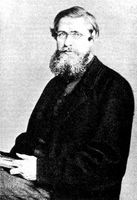 He is best known for devising a theory of the origin of species through natural selection made independently of Darwin.
He is best known for devising a theory of the origin of species through natural selection made independently of Darwin.
Between 1854 and 1862, Wallace assembled evidence of natural selection in the Malay Archipelago, sending his conclusions to Darwin in England. Their findings were jointly presented to the Linnaean Society in 1858. Wallace found that Australian species were more primitive, in evolutionary terms, than those of Asia, and that this reflected the stage at which the two continents had become separated. He proposed an imaginary line (now known as Wallace's line) dividing the fauna of the two regions.
The Alfred Russel Wallace page HERE. More HERE.
Wallace (Jan. 8, 1823 – Nov. 7, 1913) was a British naturalist and biogeographer. He was the first westerner to describe some of the most interesting natural habitats in the tropics.
 He is best known for devising a theory of the origin of species through natural selection made independently of Darwin.
He is best known for devising a theory of the origin of species through natural selection made independently of Darwin.Between 1854 and 1862, Wallace assembled evidence of natural selection in the Malay Archipelago, sending his conclusions to Darwin in England. Their findings were jointly presented to the Linnaean Society in 1858. Wallace found that Australian species were more primitive, in evolutionary terms, than those of Asia, and that this reflected the stage at which the two continents had become separated. He proposed an imaginary line (now known as Wallace's line) dividing the fauna of the two regions.
The Alfred Russel Wallace page HERE. More HERE.
Friday, January 06, 2012
Died This Day: Jean-Étienne Guettard
Guettard (Sept. 22, 1715 - Jan. 6, 1786) was a French geologist and mineralogist who made the first survey  to make a geologically map of France and to study the exposed rock strata of the Paris Basin.
to make a geologically map of France and to study the exposed rock strata of the Paris Basin.
He was first to identify several fossil species from the Paris area. Noting that certain plants occurred only in association with certain minerals and rocks, he travelled and mapped plant distributions and the occurrence of various minerals and rocks. The publication of his map in 1751 marks the beginning of the science of geology.
He also recognized erosion by running water, how subterranean water made caves and the battering of cliffs by the seas. He discovered the volcanoes of the Auvergne and the surrounding landscape shaped by past eruptions, cinder layers, old soils and solidified lava. From Today In Science History. image
 to make a geologically map of France and to study the exposed rock strata of the Paris Basin.
to make a geologically map of France and to study the exposed rock strata of the Paris Basin.He was first to identify several fossil species from the Paris area. Noting that certain plants occurred only in association with certain minerals and rocks, he travelled and mapped plant distributions and the occurrence of various minerals and rocks. The publication of his map in 1751 marks the beginning of the science of geology.
He also recognized erosion by running water, how subterranean water made caves and the battering of cliffs by the seas. He discovered the volcanoes of the Auvergne and the surrounding landscape shaped by past eruptions, cinder layers, old soils and solidified lava. From Today In Science History. image
Died This Day: Gregor Mendel
From Today In Science History:
Mendel (July 22, 1822 – Jan. 6, 1884) was an Austrian pioneer in the study of heredity. He spent his adult life with the Augustinian monastery in Brunn, where as a geneticist,
botanist and plant experimenter, he was the first to lay the mathematical foundation of the science of genetics, in what came to be called Mendelism.
Over the period 1856-63, Mendel grew and analyzed over 28,000 pea plants. He carefully studied for each their plant height, pod shape, pod color, flower position, seed color, seed shape and flower color. He made two very important generalizations from his pea experiments, known today as the Laws of Heredity. Mendel coined the present day terms in genetics: recessiveness and dominance.
Mendel (July 22, 1822 – Jan. 6, 1884) was an Austrian pioneer in the study of heredity. He spent his adult life with the Augustinian monastery in Brunn, where as a geneticist,

botanist and plant experimenter, he was the first to lay the mathematical foundation of the science of genetics, in what came to be called Mendelism.
Over the period 1856-63, Mendel grew and analyzed over 28,000 pea plants. He carefully studied for each their plant height, pod shape, pod color, flower position, seed color, seed shape and flower color. He made two very important generalizations from his pea experiments, known today as the Laws of Heredity. Mendel coined the present day terms in genetics: recessiveness and dominance.
Born This Day: George Ledyard Stebbins
From the U Calif., Berkeley:
Along with Dobzhansky (1900 - 1975), animal systematist Ernst Mayr, and paleontologist George Gaylord Simpson (1902 - 1984),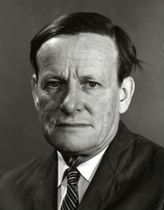 Stebbins (Jan. 6, 1906 - Jan. 19 2000) is considered one of the "architects" of the modern evolutionary synthesis of the 1930s and 1940s, an intellectual watershed and historic turning point that brought together research in cytology, genetics, systematics, paleontology into a common evolutionary framework. This synthesis, which had the effect of reconciling the often opposing views of laboratory-oriented geneticists and natural history oriented systematists, made Charles Darwin's theory of evolution by natural selection the centerpiece of the new discipline of evolutionary biology.
Stebbins (Jan. 6, 1906 - Jan. 19 2000) is considered one of the "architects" of the modern evolutionary synthesis of the 1930s and 1940s, an intellectual watershed and historic turning point that brought together research in cytology, genetics, systematics, paleontology into a common evolutionary framework. This synthesis, which had the effect of reconciling the often opposing views of laboratory-oriented geneticists and natural history oriented systematists, made Charles Darwin's theory of evolution by natural selection the centerpiece of the new discipline of evolutionary biology.
In this role, Stebbins is credited with bringing a modern framework to the study of plant evolution, and he is perhaps best known for his book Variation and Evolution in Plants, published by Columbia University Press (NY) in 1950. In the 1940s, Stebbins also played an important role in organizing the nascent Society for the Study of Evolution, of which he became the third president in 1948, and used his position to speak out for the botanical side of evolutionary studies, a field that had been dominated by zoologists. Photo .
Along with Dobzhansky (1900 - 1975), animal systematist Ernst Mayr, and paleontologist George Gaylord Simpson (1902 - 1984),
 Stebbins (Jan. 6, 1906 - Jan. 19 2000) is considered one of the "architects" of the modern evolutionary synthesis of the 1930s and 1940s, an intellectual watershed and historic turning point that brought together research in cytology, genetics, systematics, paleontology into a common evolutionary framework. This synthesis, which had the effect of reconciling the often opposing views of laboratory-oriented geneticists and natural history oriented systematists, made Charles Darwin's theory of evolution by natural selection the centerpiece of the new discipline of evolutionary biology.
Stebbins (Jan. 6, 1906 - Jan. 19 2000) is considered one of the "architects" of the modern evolutionary synthesis of the 1930s and 1940s, an intellectual watershed and historic turning point that brought together research in cytology, genetics, systematics, paleontology into a common evolutionary framework. This synthesis, which had the effect of reconciling the often opposing views of laboratory-oriented geneticists and natural history oriented systematists, made Charles Darwin's theory of evolution by natural selection the centerpiece of the new discipline of evolutionary biology. In this role, Stebbins is credited with bringing a modern framework to the study of plant evolution, and he is perhaps best known for his book Variation and Evolution in Plants, published by Columbia University Press (NY) in 1950. In the 1940s, Stebbins also played an important role in organizing the nascent Society for the Study of Evolution, of which he became the third president in 1948, and used his position to speak out for the botanical side of evolutionary studies, a field that had been dominated by zoologists. Photo .
Subscribe to:
Posts (Atom)


